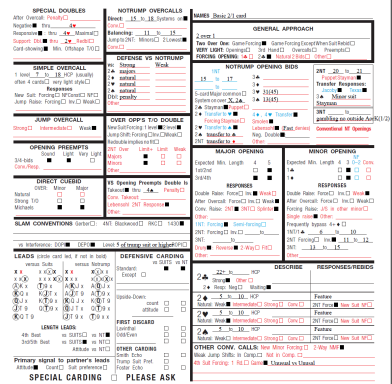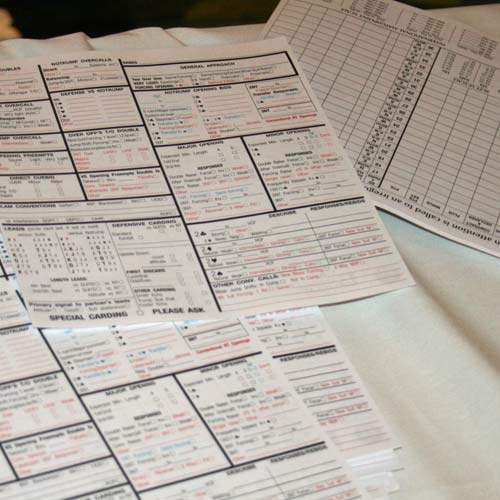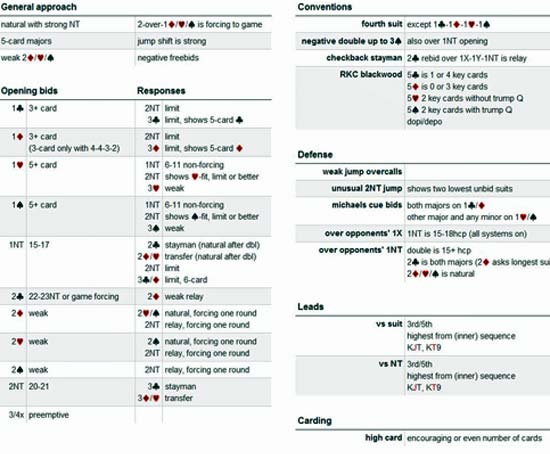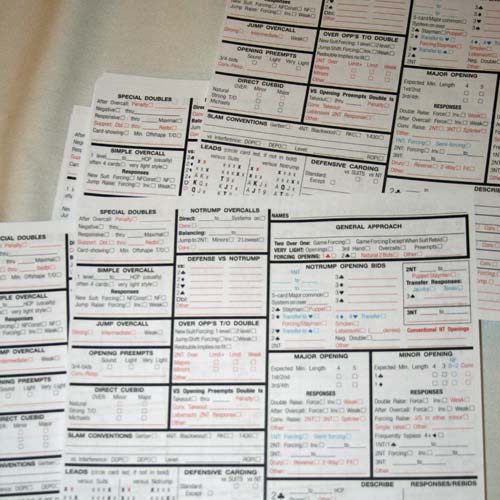Playing online bridge some partnerships will use bidding conventions to improve their partnership’s ability to arrive at the ideal contract during the auction. The dictionary definition of a convention is an agreement, compact or a contact that deals with a specific matter. The definition of convention continues with it being a general agreement or accepted usage. The Official Encyclopedia of Bridge defines a convention as a call or play with a defined meaning. These definitions describe conventions perfectly, as a convention is an agreement between partners that is used to signal one another information about their hands through the meaning of their bids in order to arrive at the best possible contract.

Bridge conventions have been used for many years with many of the conventions undergoing many changes while others have stayed the same since their conception. The conventions are used and recognized internationally. Since in bridge you may not directly communicated with your partner during a hand, the many conventions are practical tools for communication between partners during the hand.
All bridge conventions serve a purpose, however, that purpose might be different than other bidding conventions. Many common conventions can be classified as opening bid with some focusing on strong opening bids and others focusing on weak opening bids. Fit seeking conventions focus on finding a trump suit between the partnership. Slam seeking conventions in bridge like Blackwood, Cue bids, Jacoby 2NT, Relay bids and Asking bids are ever so important for partnerships in duplicate bridge tournaments.
Not all common bidding conventions are offensive as there is a plethora of defensive conventions. These defensive bidding conventions are also known as interventions and include the Takeout Double and defenses over 1NT. Two suited over calls are common approaches on defense that can make a big difference in the score.
Knowing the natural defensive actions of your opponents coupled with the knowledge of their defensive conventions they are using makes for opportunities during the auction. Counter-interventions like the negative double, Lebensohl, Rubensohl and unusual vs. unusual make for some chances to be aggressive during game play.
Each bridge deal is unique with many 13 card hands resulting in many different balanced and unbalanced combinations with significant variability in terms of high card distribution and the number of cards in a particular suit that can be dealt to a given player. Because of this variation during each deal, bidding conventions used during the auction were created by average and expert bridge players in order to share valuable information with their partners. The difficulty with conventions for beginning bridge players is the fact that there are many conventions and there are many different meanings for different bids depending on the convention being used. If a player is able to understand the convention being used by their partner or the opponents then that player will be more apt to understand the card distribution among the four hands in play. The bidding system aims to improve the efficiency of the bids by making calls that otherwise would have had little meaning with calls that have a predetermined meaning. The ability to pass and receive information from your partner and the ability to comprehend the information being exchanged from your opponents’ calls make a big difference in your success during contract bridge games.
There are many different conventions, some of the most commonly used bridge bidding conventions are these listed here:
- Stayman: super popular convention that is a part of many partnership’s bidding systems. The Stayman convention is used by a responser who is looking to find a major suit fit after an opening 1NT bid.
- Puppet Stayman: a specific form of the popular Stayman that is used in response to a 2NT opening bid.
- The Cappelletti which is also known as the Hamilton is an over bid following a 1 no trump: when opponents bids 1NT you bid over them to interfere safely. A well known convention that like many others was named for the person who created it. Michael Cappelletti developed a standard way to defend when an opponent opens no trump.
- DONT over 1NT: Disturb the Opponents No Trump
- DOPI, ROPI, DEPO: are used when opponents are interfering with Blackwood
- Fourth Suit Forcing: is the popular expression for when a bid by responder during his second turn is the only unbid suit at that point, this is then an artificial force.
- Weak Two level bids: a weak two bid is often used for two reasons. The first is to describe your hand to your partner in order for them to make a better decision on how high to bid and in what suit. The other reason is to help your partner figure out what card to lead with if your partnership is defending. The weak two level bid is a common bridge convention that is
- Jacoby Transfers: after a 1NT opening, the response used in order to easily describe your hand to your partner asking them to bid in a certain suit so that the strong hand becomes the declarer.
- Jacoby 2NT: Oswald Jacoby devised the idea of 2NT as a means to respond by forcing a raise after opponent bid 1 of a major suit, 1 Heart or 1 Spade.
- Smolen: a twist on Jacoby Transfers that uses Stayman to help find a fit and arrive at the ideal contract.
- Texas Transfers: usually used with Jacoby Transfers.
- Michaels: cuebid
- Negative Doubles: used often it is applied to signal strength and length in unbid suits, usually the majors.
- New Minor Forcing: a low level forcing bid by a responder after opener rebids 1NT
- Splinters: helps avoid missing a game or slam opportunity by raising under the right circumstances.
- Responsive Doubles: known as a takeout double is to ask your partner to make a bid because of the circumstances of your holding possibly being a fit but being unsure of which suit that fit might be.
- Responding to a Takeout Double: The response to a low level double that comes usually after an opponent has made a one level bid. The takeout double tells partner to bid an unbid suit.
- Blackwood: determines the number of aces your partnership possesses in order to see if a slam is attainable
- Roman Key Card Blackwood: is a variation on Blackwood that focuses on the key cards to determine if partnership has enough to go for slam.
- Unusual vs. Unusual: defense against two-suited over calls.
Because of the countless number of card distributions, bridge bidding conventions are often open to interpretation. In order to reduce interpretation mistakes, partnerships must form a partnership agreement in order to better define the meanings of their bids. Even with partnership agreements in place, bidding mistakes between partners is a regular situation and the best partners do not get overly upset with one another when that happens but instead discuss it afterwards in order to avoid future errors and if needed to make changes to their partnership agreement. The partnership agreement helps to define the definition of a convention between the partnership which improves the line of communication.
During bidding only 15 words are allowed to be spoken so bridge players have created many conventions. These special bids are used to describe the strength of their hand as well as the suit distribution of their hand. Officially, the 15 words allowed to be spoken during the bridge bidding auction each hand are:
- Pass
- Double
- Redouble
- One
- Two
- Three
- Four
- Five
- Six
- Seven
- Club
- Diamond
- Heart
- Spade
- No Trump
Additionally, a few words have been added to the 15 by the ACBL in order to signal opponents to unusual bidding. These additional words are:
- Stop: Is when a bidder plans on jumping the bidding, he or she will say ‘stop’ in order to allow opponents extra time to figure out their bids.
- Alert: Is a warning to opponents that the last bid made by your partner means a bridge convention is being used.
- Announcement: a few words that will directly tell the opponents the meaning of a partner’s call after he or she has bid. This is part of the alert situation which deals with three specific situations. These are to tell the range of your partner in high card points when opening 1NT. For example, detailing your partner’s bid represents 15-17 or 16-18 high card points. The second use of the announcement is when a partner uses a Jacoby Transfer bid after an NT opening. The final time an announcement is used is in the scenario where a partnership uses a forcing 1NT response.
Bidding Conventions in Bridge

Conventions are part of the bidding system that has been chosen before the match between the partners and communicated to their opponents. Contract bridge conventions are customized parts of the bidding system which help the pair reach agreement on a makable contract. Some of the major Bidding systems have certain conventions built into the system while some conventions are more customized by the partnership.
The bidding system maps out the meaning of each bid amongst a Bridge pair. The main system chosen by the pair is usually adjusted with conventions for dealing with certain bidding situations.
The two main reasons bidding conventions are used:
- Need to transfer information that is more informative than simply whether a partner prefers/does not prefer a certain suit.
- Making the bidding more efficient by replacing calls with little meaning with calls that have a pre-determined meaning.


